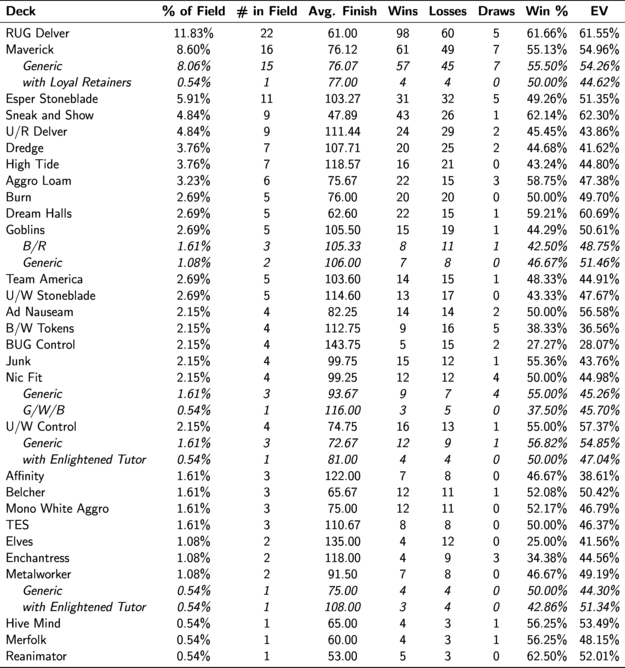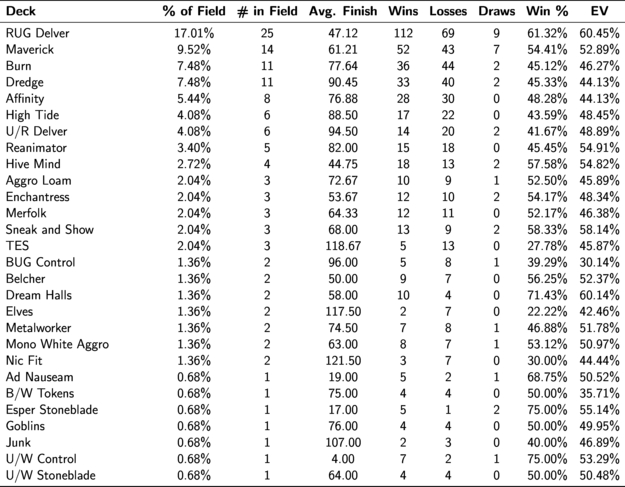Welcome back to Too Much Information! When we last left off, U/W Stoneblade was the deck to beat, Maverick and RUG were the best performers, and Burn was enjoying a dramatic surge of popularity. That was three months ago, and while many of the same archetypes are all still around today, their positions in the metagame have shifted substantially. This time, we’ll be looking at data from SCG Open Series Madison and Orlando.
Madison Legacy Open
The first thing that’s changed is that RUG Delver, which has long been one of the most successful decks in the format but hadn’t been among the most popular in the last few events we looked at, finally reached the top in Madison. Its win percentage has always been incredibly high, but this showing is even better than usual. Interestingly it’s estimated Expected Value (EV), based on historical matchup data going all the way back to the release of Innistrad (and banning of Mental Misstep), was close to its actual win percentage, suggesting that the strong showing was not a fluke.
Maverick being the second-most popular deck is no surprise; it’s been a deck to beat since the beginning of the season, and it’s seen no small amount of success. A 55% win percentage, while quite good, is no higher than we had come to expect from Maverick.
What is more surprising is that Stoneblade fell down to third place. U/W Stoneblade was the most popular deck in first three SCG Opens of 2012 and near the top in the next two. In those five events, it only dropped below ten percent of the field once. In the wake of Grand Prix Indianapolis, Esper Stoneblade largely supplanted U/W. However, not even the two together made up as much of the Madison field as U/W alone used to (8.6%, equal to Maverick), and less than six percent of players played Esper Stoneblade itself. Esper Stoneblade only won about half of its matches, and its EV was only slightly better.
Tied for fourth we have Sneak and Show, which did so well that it actually slightly beat RUG’s win percentage. Of all the decks that stand out, this one has changed the most thanks to Griselbrand, so we don’t have much relevant matchup data for Sneak and Show (only the matches from these two events). With the deck being relatively unpopular, that means we don’t really have enough information to put much stock in its EV or break down its matchups in detail yet. What we do know is that it had more success at winning matches in Madison than every other deck with at least two players, and that fact is quite impressive.
U/R Delver was as popular as Sneak and Show but much less successful. It performed much worse in Madison than it did earlier in the year.
Dredge and High Tide were next and performed similarly badly.
Interestingly, Burn was much less popular in Madison than it was in the last few tournaments we looked at—it was the most popular deck back in Tampa but had only five players this time.
Orlando Legacy Open
RUG Delver not only stayed on top for Orlando; it made up a whopping seventeen percent of the field. The field was smaller than in Madison (147 players as opposed to 186), but the number of RUG players actually increased. Not only that, but RUG retained its absurdly high win percentage. It’s rare that the most popular deck is also the most successful, and to be both by such a large margin is even more unusual.
In fact, the only other time we’ve seen a deck simultaneously make up at least ten percent of the field and win at least 60% of its matches, was Survival. RUG Delver has done this twice in a row. (Of course, Survival did this three times in a row and was awfully close a few more times, with its worst win percentage being 59.38%. RUG hasn’t been quite that consistent.) Again, the EV matches the win percentage.
Maverick stayed in about the same place in terms of field percentage and win percentage: respectable, but clearly behind RUG in both respects.
Burn and Dredge were much more popular in Orlando than in Madison. They didn’t do any better, on average, despite the fact that Dredge won the tournament!
Affinity showed up this time but didn’t quite break even in match wins.
High Tide and U/R Delver were about as popular as they were in Madison, and they performed about as poorly.
This time Stoneblade almost completely disappeared, with only one U/W and one Esper player. Sneak and Show was also less popular than in Madison, though the three people who did play it did well.
Now we’ll look at some of the matchup data from these events:
RUG Delver — 14.11% of field, won 61.47% of matches
Creatures (12)
Lands (19)
Spells (29)
- 4 Brainstorm
- 4 Lightning Bolt
- 3 Force of Will
- 3 Daze
- 3 Spell Snare
- 4 Ponder
- 3 Spell Pierce
- 3 Forked Bolt
- 2 Thought Scour
Sideboard


These matchups shed some light on why RUG is doing so well. It actually doesn’t seem to have a historically bad matchup among the popular decks of either event, although it was behind by a single game against Dredge if we look at just these two tournaments. The most interesting result here is that it did well against Maverick this time, which has traditionally been problematic for RUG. (Including the positive record from these two tournaments only brings the overall record to about even.) RUG’s other matchups aren’t completely lopsided, but they all appear positive.
Maverick — 9.01% of field, won 54.79% of matches
Creatures (25)
- 4 Mother of Runes
- 1 Birds of Paradise
- 1 Scryb Ranger
- 1 Aven Mindcensor
- 3 Noble Hierarch
- 4 Knight of the Reliquary
- 2 Qasali Pridemage
- 1 Stoneforge Mystic
- 1 Linvala, Keeper of Silence
- 2 Fauna Shaman
- 2 Scavenging Ooze
- 3 Thalia, Guardian of Thraben
Planeswalkers (1)
Lands (23)
Spells (11)


Maverick’s matchups are also impressive. It is historically favored against Burn, Esper Stoneblade, Dredge, and Affinity. While it didn’t do as well against Dredge this time, it did better against Burn. The RUG matchup is certainly the most important question. It may turn out that RUG’s recent lead is just noise, with the actual matchup being close to even, but it may be that Maverick is actually behind against current RUG builds.
Dredge — 5.41% of field, won 45.08% of matches
Creatures (22)
- 3 Putrid Imp
- 3 Ichorid
- 1 Flame-Kin Zealot
- 4 Golgari Grave-Troll
- 2 Golgari Thug
- 4 Stinkweed Imp
- 4 Narcomoeba
- 1 Griselbrand
Lands (14)
Spells (24)


Dredge, on the other hand, does not seem well positioned. Its RUG matchup looks even to bad, and its Maverick matchup looks bad to worse. It has historical leads over Burn and Affinity, but it seems to have problems with the more important decks, leading to a poor win percentage. However, we’ve seen Dredge’s win percentage fluctuate enough from event to event that it may turn out to be a better choice later on.
Burn — 4.80% of field, won 46.72% of matches
Creatures (11)
Lands (19)
Spells (30)
- 4 Lightning Bolt
- 4 Fireblast
- 4 Chain Lightning
- 4 Price of Progress
- 4 Lava Spike
- 4 Flame Rift
- 4 Rift Bolt
- 2 Thunderous Wrath
Sideboard


Burn, on the other hand, has been much more consistently lackluster, and this table shows some of the reasons why. Its overall record against all the other popular decks from these tournaments is negative. Looking at Madison and Orlando by themselves, Burn was able to make just one of those matchups positive (Dredge) by just one match. This is the complete inverse of RUG’s matchups which, unsurprisingly, leads to a low win percentage.
Esper Stoneblade — 3.6% of field, won 51.97% of matches
Creatures (8)
Planeswalkers (3)
Lands (22)
Spells (27)


We have very little data for Esper Stoneblade because these are the only two tournaments we’ve looked at since it’s been a particularly relevant deck, and it only showed up in reasonable numbers at one of the events. It seems to have trouble with both RUG and Maverick, which does not bode well, but it won a little over half of its matches and has been slightly favored against the other popular decks.
Affinity — 3.3% of field, 47.95% of matches
Creatures (28)
Planeswalkers (2)
Lands (15)
Spells (15)
Sideboard


Affinity won slightly less than half of its matches. Many of those losses were to RUG, which looks like a terrible matchup. It seems to have close but possibly unfavorable matchups against Maverick and Dredge. Affinity is solidly ahead against Burn, but that’s really the only good news for it in this table.
The one thing that’s clear from all of this is that you need a pretty good reason to play something other than RUG Delver. Sneak and Show, if its performance in Madison is typical, could turn out to be a similarly amazing deck, but nothing else comes close. Maverick is still a reasonable choice. It isn’t winning nearly as much as RUG is, but it’s still far ahead of almost everything else.
As far as popular decks go, those are really the only attractive choices. Stoneblade looks about average, and Burn, Dredge, Affinity, and U/R Delver look worse. Aggro Loam and Hive Mind did well in both events, but they showed up in numbers too small for us to confidently recommend them.
The most popular deck is clearly RUG Delver. Whether you’re playing it or not (and, again, you probably should be), you should be concerned with beating it. Maverick is another consistent presence. These were the only decks which were popular in both Madison and Orlando. As we look at a few more tournaments, we’ll hopefully be able to identify which of the other archetypes we can expect more often.
Join us next time as we continue to gather data about the current Legacy metagame. Until then, good luck at the next SCG Open Series in Worcester!
Alix Hatfield
Jesse Hatfield


